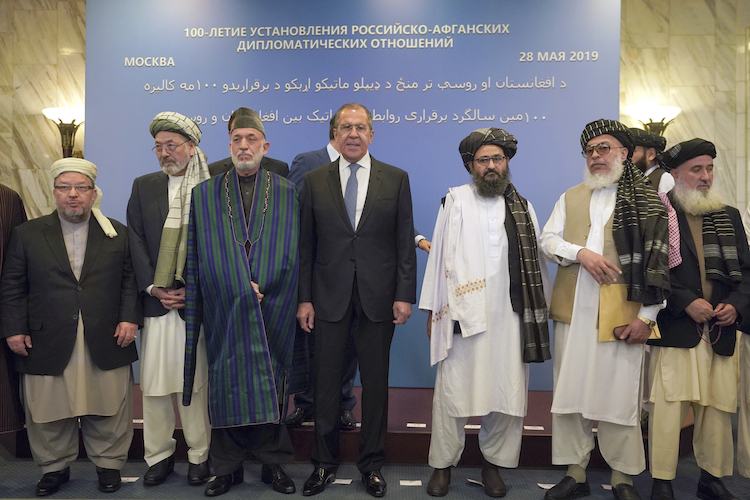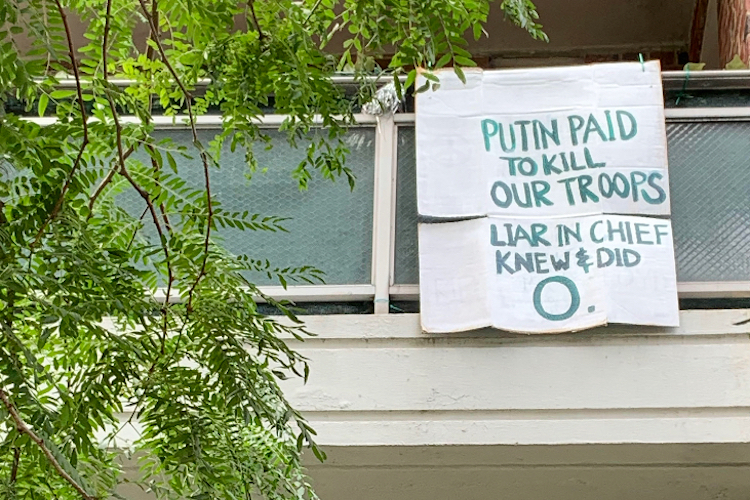Lacking a superpower’s resources, the Kremlin has tapped into its Soviet toolkit of active measures in pursuit of geopolitical strength. While influence campaigns stress-test democracies and disrupt political discourse around the world, the US—with its deep political schisms—remains particularly vulnerable to their damaging effects.

Last May, Russia’s Foreign Minister Sergei Lavrov hosted Taliban delegates in Moscow as part of celebrating a centennial anniversary of Russian-Afghan diplomatic relations, despite the fact that Taliban is recognized as a terrorist organization and banned in Russia. Following the recent US media reports, head of Russia's Security Council Nikolai Patrushev bluntly denied any ties with Taliban, accusing CIA of creating this organization. Photo: Emin Dzhafarov / Kommersant / Sipa via AP Images.
At the end of June, the New York Times broke a story about American intelligence reports claiming that members of a Russian military intelligence (GRU) unit offered to pay bounties to Taliban fighters to kill US and allied soldiers in Afghanistan. While the reports appear credible, there is some disagreement within the intelligence community about the quality of the evidence on which they are based. And at least one prominent security analyst, Mark Galeotti, has argued that the narrative, involving drug dealers and warlords, “seems to stretch probability to [the] breaking point.”
Whether or not the intelligence is eventually fully substantiated, the news has already had a considerable political impact. President Donald Trump, in addition to denying that he was briefed on the issue back in March, dismissed the reports as “another fabricated Russia Hoax.” Democrats in Congress, meanwhile, have called for an official warning to be issued to President Vladimir Putin.
Reactions to news of malign actions by Russian forces working outside the country’s borders highlight both the difficulty of crafting coherent policy responses to these so-called “active measures” and the degree to which the Kremlin’s strategy of disruption has already damaged American political discourse.
From active measures to Internet trolls
Much has been made of Putin’s past as a KGB officer in East Germany. Yet his background as a former security services agent is not unique in Russia. Before the collapse of the Soviet Union, the KGB employed half a million people. In the early 1990s, Boris Yeltsin deliberately fragmented the state security system into a number of successor agencies and reduced their budgets. This led to the dismissal of tens of thousands of agents who found employment in private security firms where they worked to provide kompromat, or compromising material, and chernyi piar, or black PR, to anyone willing to pay. Many of these people eventually made their way into Russia’s political ecosystem and have come to be known as the siloviki, a word derived from the Russian word for “force,” which denotes those with a background in the security services, the military, and the police.
For Putin and the siloviki, strength is a central political goal. At home, strength is the centralization of political power in the Kremlin. Abroad, strength is recovering what Putin and his supporters view as Russia’s lost status as a superpower. In the absence of superpower resources, active measures are a useful geopolitical tool in the pursuit of strength.
The term “active measures” comes from the Cold War and was used to describe a range of activities conducted by Soviet intelligence services, which included propaganda, media manipulation, financial support for foreign agents and groups, kidnappings, assassinations, and even terrorism. Active measures exerted political influence outside of the borders of the USSR while providing Soviet authorities with plausible deniability. Much like the security services themselves, active measures experienced a post-Soviet transformation.
Active measures became what is now widely dubbed “hybrid warfare”—a combination of political, economic, informational, and other non-military covert measures used to weaken a state or organization. Russia views itself as the target of hybrid warfare through a Western-led campaign to destabilize the post-Soviet region via popular uprisings and color revolutions. Tapping into its Soviet toolkit, Russia has developed tactics to disrupt and destabilize in turn.
One of the most striking examples of these tactics is by now well-known to Americans: efforts to meddle in the 2016 presidential election by hacking Democratic Party operatives, releasing damaging political information, and spreading propaganda while intentionally obscuring its origin. Other examples include the financing of far-right political parties in Europe; cyberattacks on NATO, the European Union, and individual European states; and assassinations or attempted assassinations of former spies and double agents living abroad. These measures are much cheaper than conventional warfare, can be deployed in a variety of contexts, and allow Russia to play the great power game without great power resources.

A reaction to NYT’s reporting on the so-called “Talibangate” is seen in Queens, NY. Photo: courtesy of the author.
The impact of trolls
The degree to which Russian influence campaigns succeed is difficult to measure, and their actual impact on political outcomes is not well understood. There is evidence that at least some of these campaigns end in striking failure. For example, the Atlantic Council’s Digital Forensic Research Lab recently revealed that a long-running Russian information campaign called “Secondary Infektion,” which spread fake stories and forged documents via social media accounts in Europe and North America between 2014 and 2020, had almost no success reaching mainstream online or media conversations. Even in the US, where Russian trolls were shown to actively exploit political divides on Twitter during the 2016 presidential election, the actual impact of this strategy on the election’s outcome remains uncertain.
Even when they do not achieve a concrete political outcome, Russian influence campaigns can destabilize and disrupt political systems. And reactions sparked by the reports of alleged Taliban bounties show that these campaigns have done significant damage in America. Trump’s White House continues to take aim at the media rather than engage in a conversation about how to address Russian aggression. Tough sanctions on Russia are held in place by a Congress which is at odds with the presidential administration. Meanwhile, Trump’s opponents have used stories of collusion with Russia as a political cudgel against the president. The Lincoln Project, a political action committee founded last year by several prominent Republicans and former Republicans, recently produced an anti-Trump video filled with so much Communist imagery that it could be easily mistaken for a propaganda reel made by Senator Joseph McCarthy at the height of the Red Scare.
Influence campaigns are cheap, adaptable, and deniable, making them difficult to counter with state policies. Yet Baltic countries, for example, have developed strategies to address and deter Russian aggression through coordination between government agencies, private businesses, and volunteers. These strategies quickly counter cyberattacks and limit the impact of disinformation. These kinds of effective policies are only possible, however, when there is a “political acknowledgement” of the threat of influence campaigns. Without such an acknowledgement, a comprehensive response is almost impossible.
Scholars have argued that influence campaigns are opportunistic attempts to exploit existing weaknesses that are best deterred by the belief in the “legitimacy of existing political structures.” They are most effective where social schisms are already exposed. At present, with polarizing partisanship, low-quality media, and a lack of consensus about the threats facing it, America remains extremely vulnerable.
Yana Gorokhovskaia is a political scientist researching civil society and local politics in Russia. From 2016 to 2019, she was a postdoctoral scholar in Russian Politics at the Harriman Institute for Russian, Eurasian, and East European Studies.

